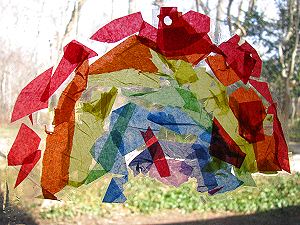
We tried a new craft for our rainbow play date this year, using clear contact paper and tissue paper. Last year we made ours with dyed pasta and we’ve also made sun catchers with glue, clear plastic, and tissue paper. I thought the contact paper would be simpler for the younger children, however, we found it was actually more challenging.
Materials
- red, orange, yellow, green, blue, indigo, and violet tissue paper
- contact paper
- rainbow template
- painter’s tape or masking tape
Directions
1. Place the template on the table and then place the clear contact paper, sticky side up, on top of the template. Tape both down with painter’s tape or masking tape. (Note: The biggest mistake I made here was not preparing this ahead of time. The kids tried to dive right in before I had a chance to tape everything down and they got frustrated when the contact paper moved around and shifted and crinkled.)
2. Tear up pieces of red tissue paper and place on the sticky contact paper along where you see the red arc on the template. Repeat for the other colors.
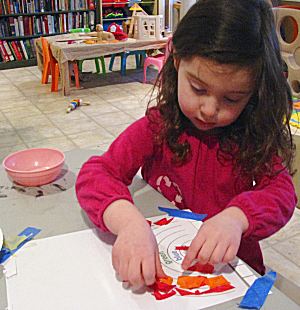
3. Fold the top half of the contact paper down over the rainbow and trim.
4. Tape to the window or use a single hole punch and thread fishing wire through the hole. Enjoy!
Books About Rainbows
The Leprechaun Who Lost His Rainbow: We have really been enjoying this sweet story about a young girl who helps a leprechaun build a rainbow. She sacrifices her favorite things so that the sun will shine on her grandfather playing the bagpipes in the St. Patrick’s Day Parade. Her generosity is rewarded and she makes a special connection with her grandfather. The story allows for lots of anticipation questions and post-reading discussion about our own favorite things and what has the most meaning in our lives.
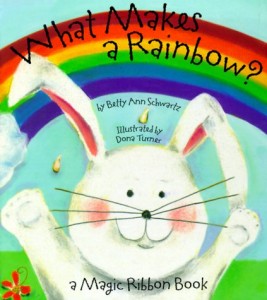
What Makes A Rainbow? In this cute tale, a young bunny asks his colorful friends what makes a rainbow. With each turn of a page, a new ribbon joins the rainbow. The kids love calling out the colors and spotting all the animals.
Educational Connections
- Science: Investigate what makes a rainbow in an age-appropriate way. Recreate a rainbow with a garden hose on a sunny day. Does the rainbow appear when the sun is behind or in front of the spray of water? Younger children will learn that sun shining through the water droplets makes a rainbow. Older children will learn that light is made up of all colors and that the water acts like a prism, splitting the light into separate colors. Advanced students may study the different wavelengths of colors.
- Weather: Once children understand what makes a rainbow, ask what types of weather are likely conditions for a rainbow and in which season(s) rainbows would be most common.
- Ecology: Can you find a plant or animal for each color of the rainbow? Make a rainbow collage of the pictures.
- Home Arts: “Eating a rainbow” of fruits and vegetables can help you maintain a healthy diet. What do these colors mean when you see them in fruits and vegetables?
- Art: Make a rainbow with only red, yellow, and blue paint. If you blend the colors, what happens?
- History and Culture: How did other cultures view rainbows? What gods or goddesses and myths and legends are associated with rainbows?
Shared at: stART
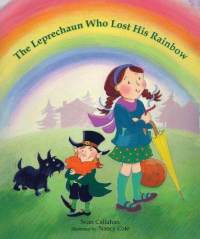
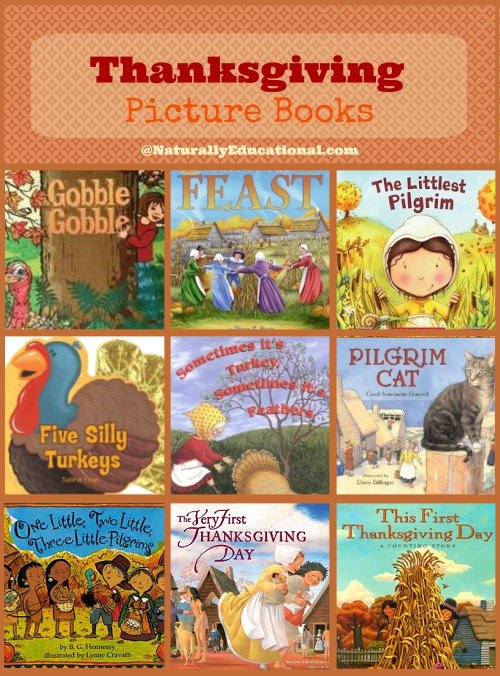
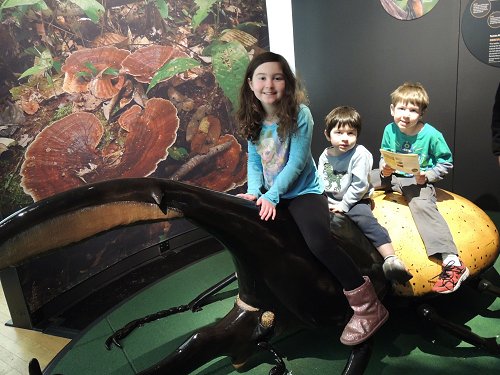
I love the rainbow suncatcher! It seems like it would be much easier if you could peel back the contact paper row by row, but I’m not sure how to do that?
I love this! So simple and beautiful!